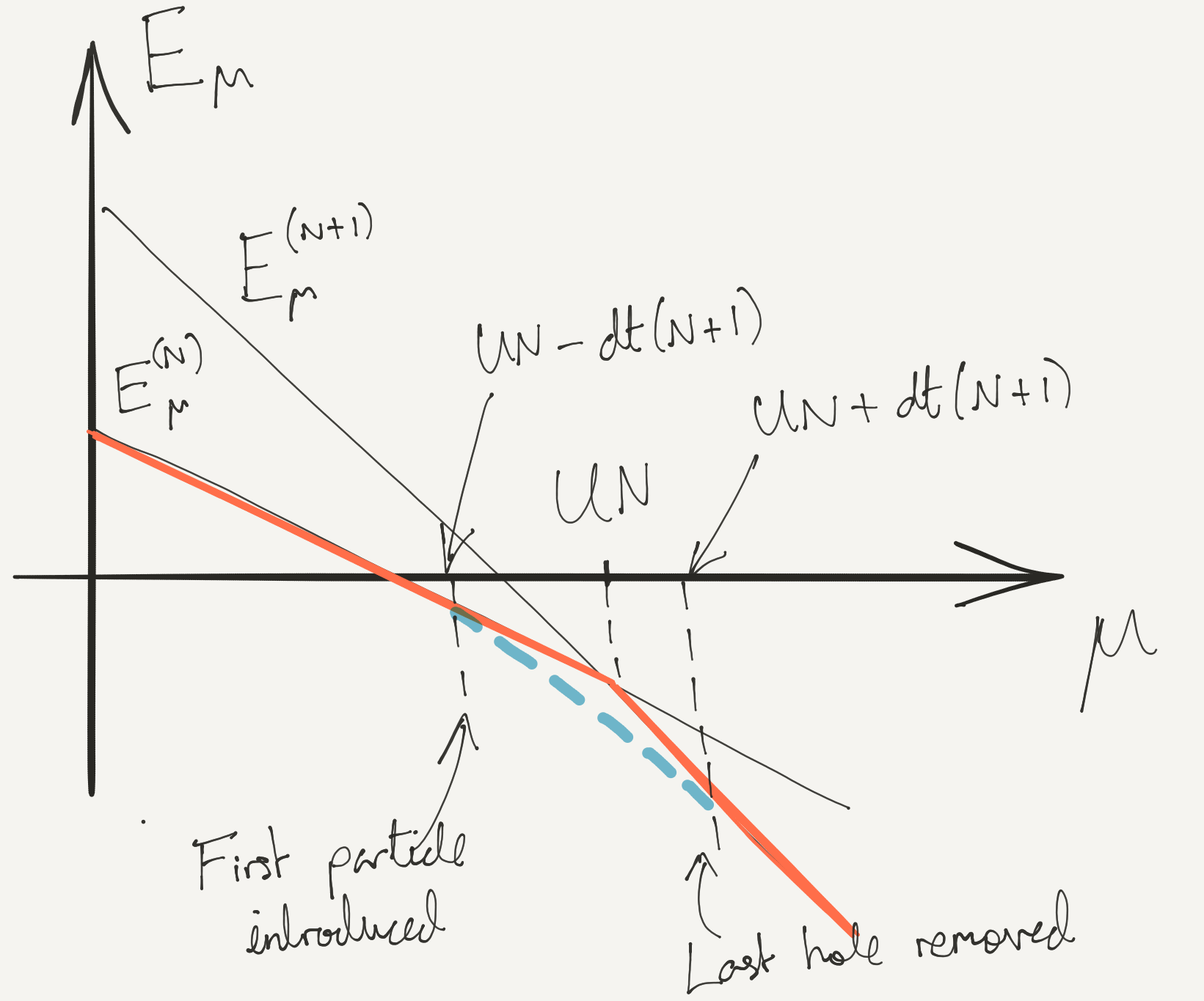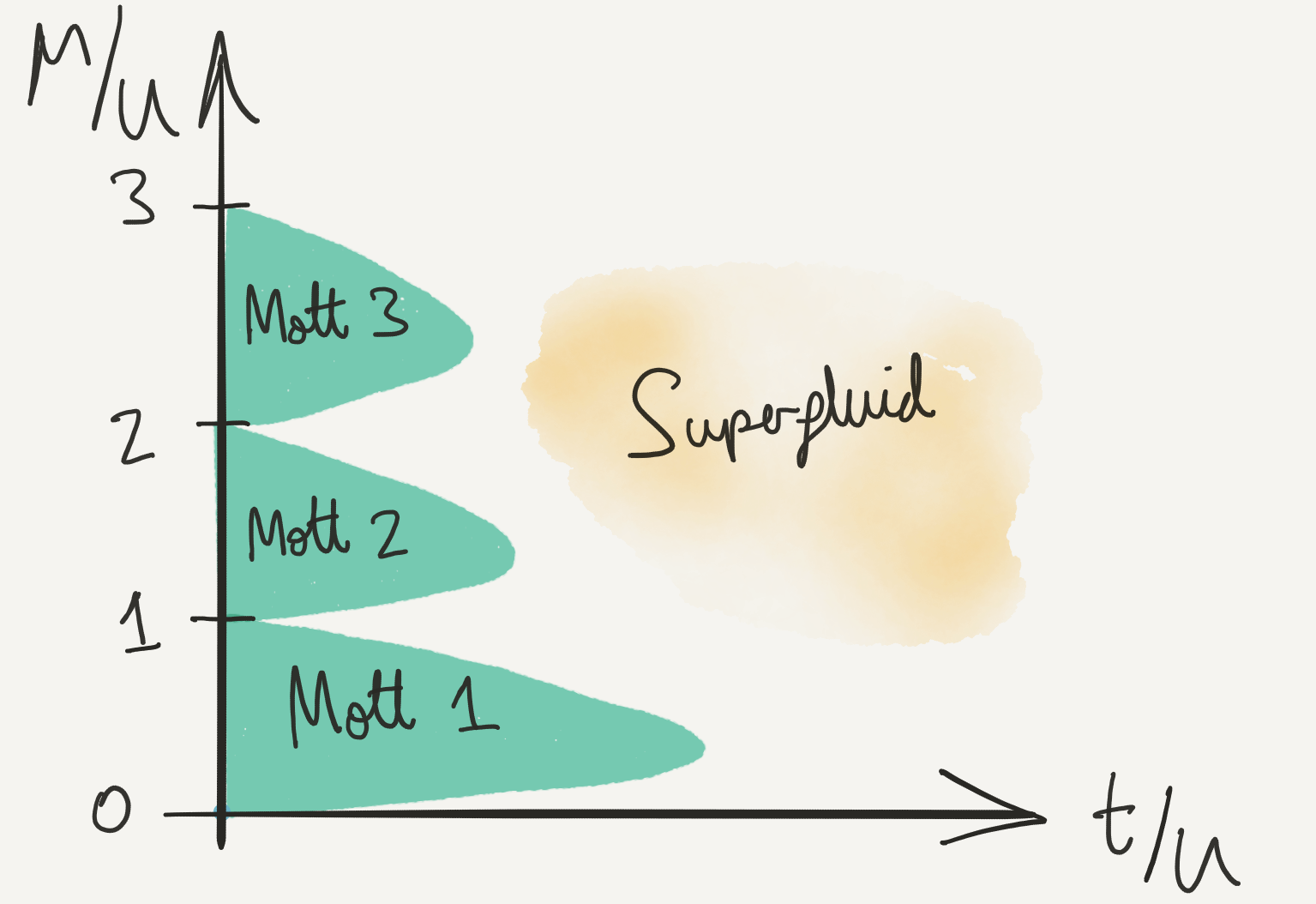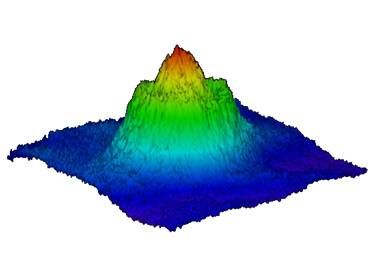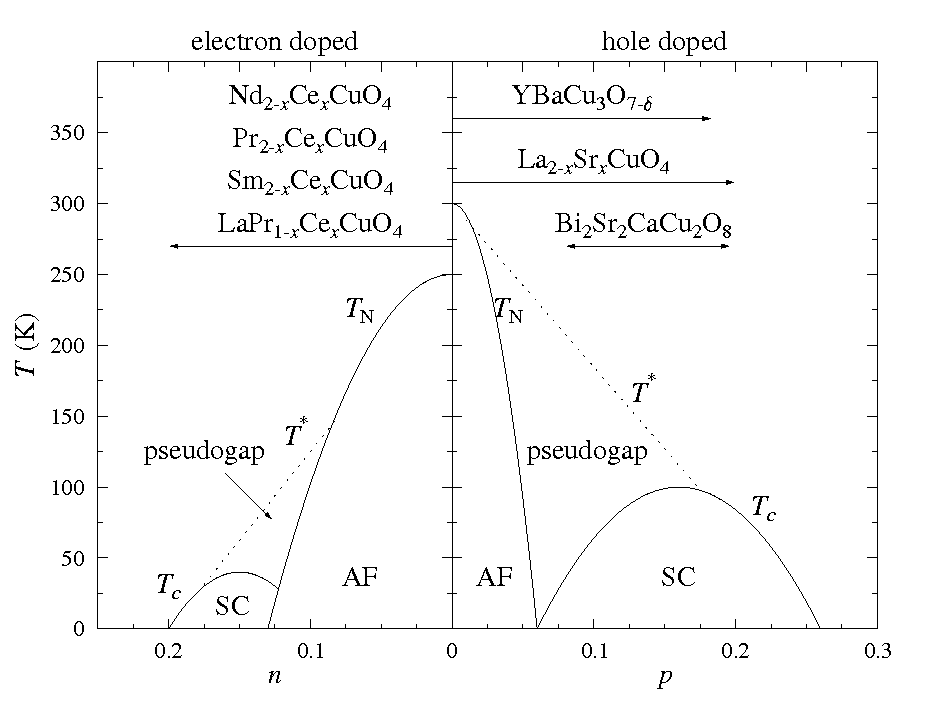Lattice Models
- Defined on a discrete lattice
- Apply to deep periodic potentials: few states / site are enough
- Capture physics of strong correlations
Tight Binding Models
- Noninteracting Hamiltonian with periodic potential $V(x+a)=V(x)$
$$ H = \sum_{j=1}^N \left[-\frac{1}{2m}\partial_i^2 +V(x_i)\right] = \int \left[\frac{1}{2m}\partial_x\pdop\partial_x\pop + V(x)\pdop\pop\right] dx, $$
Bloch’s theorem: eigenstates labelled by continuous index $k$ (crystal momentum) and discrete index $n$ (band index)
$$ \psi_{k,n}(x) = e^{ikx} \varphi_{k,n}(x), $$$\varphi_{k,n}$is periodic; $k$ lies in Brillouin zone $(-\pi/a,\pi/a]$The eigenvalues $E_n(k)$ give the energy bands.
When lattice potential deep wavefunctions in lowest band(s) highly localized
Introduce $\adop_j$, $\aop_j$ describing localized state $\varphi_j(x)$ at site $j$
$\varphi_j(x)$ not eigenstates: coupling between sites described by tight binding Hamiltonian
$$ H_t = -t \sum_{j} \left[\adop_j\aop_{j+1}+\adop_{j+1}\aop_j\right] $$
- Plays role of kinetic energy in our models (c.f. magnon in spin chain in Lecture 4
Bose Hubbard Model
Simplest interacting lattice model
$$ H = H_t + H_U = -t \sum_{\langle j\,k\rangle} \left[\adop_j\aop_{k}+\adop_{k}\aop_j\right] + \frac{U}{2}\sum_j N_j(N_j-1), $$$N_j=\adop_j\aop_j$, sum over all nearest neighboursOn-site interaction $N_j(N_j-1)=\adop_j\adop_j\aop_j\aop_j$
First introduced to describe electrons in solids; boson version widely used in ultracold atomic physics
The Mott State
- $U=0$ limit easy (no interactions); what about $U/t\to\infty$?
$$ E(\mathbf{N}) = \frac{U}{2} \sum_j N_j(N_j-1). $$
Ground state: fill $N_\text{sites}$ sites as uniformly as possible
Easy if filling $\nu \equiv N_{\text{particles}}/N_\text{sites}$ is integer
Notation: ceiling $\lceil \nu\rceil$ is smallest integer bigger than $\nu$, floor $\lfloor \nu\rfloor$ is largest integer smaller than $\mu$
Number of sites with occupancy $\lceil \nu\rceil$ is $N_\text{sites}\left(\nu - \lfloor \nu\rfloor\right)$
Ground state energy is piecewise linear in $\nu$
$$ \frac{E_0}{N_\text{sites}} = \left(\nu - \lfloor \nu\rfloor\right)e(\lceil \nu\rceil) + \left(\lceil \nu\rceil - \nu\right)e(\lfloor \nu\rfloor), $$$e(N) = \frac{U}{2}N(N-1)$Chemical potential $\mu = \frac{\partial E_0}{\partial N_\text{particles}}$ is piecewise constant
$$ \mu = e(\lceil \nu\rceil) -e(\lfloor \nu\rfloor)=U\lfloor \nu\rfloor, $$

Think about varying $\mu$: values between $UN$ and $U(N-1)$ correspond to integer filling $\nu=N$
States of integer filling are Mott states, after Nevill Mott
Effect of hopping: Mott states
Do Mott states survive when $t\neq 0$? Treat $t$ as perturbation
Unperturbed eigenstates of have fixed occupation $N_j$ on site $j$
$$ \ket{\mathbf{N}} = \bigotimes_j \ket{N_j}_j. $$
- Applying $H_t$ gives a superposition of states, each with one particle moved to an adjacent site.
How is a Mott state (all sites with the same occupation) affected by $H_t$ in first order perturbation theory?
Effect of hopping: away from Mott state
Mott state of filling $\nu=N$ + 1 extra particle
Place particle on one of $N_\text{sites}$ sites: degnerate ground state when $t=0$
$H_t$ mixes these states: degenerate perturbation theory (other states separated by energies of order $U$)
- Ground state multiplet
$$ \ket{i,+}\equiv \frac{\adop_i}{\sqrt{N+1}}\bigotimes_{j} \ket{N}_j $$
- Only states $\ket{i\pm 1,+}$ are coupled by $H_t$, with matrix elements
$$ \braket{j|H_t|k} = -t(N+1) $$
- Within degnerate multiplet, $H_t$ corresponds to tight binding model
$$ H_t\rvert_{+} = -t(N+1) \sum_{\langle j,k\rangle} \left[\ket{j,+}\bra{k,+}+\text{h.c.}\right] $$
$$ H_t\rvert_{+} = -t(N+1) \sum_{\langle j,k\rangle} \left[\ket{j,+}\bra{k,+}+\text{h.c.}\right]. $$
Only many body effect is factor of $N$ due to Bose statistics
Splitting of degenerate states given by dispersion ($d$ dimensions)
$$ \omega_+(\boldsymbol{\eta}) = -2t(N+1)\sum_{n=1}^d\cos\eta_n $$
- Alternatively remove a particle from Mott state
$$ \ket{i,-}\equiv \frac{\aop_i}{\sqrt{N}}\bigotimes_{j} \ket{N}_j. $$
- Within these states, $H_t$ takes form
$$ H_t\rvert_{-}=-tN \sum_{\langle j,k\rangle} \left[\ket{j,-}\bra{k,-}+\text{h.c.}\right] $$
$$ \omega_-(\boldsymbol{\eta}) = -2tN\sum_{n=1}^d\cos\eta_n. $$
Changes to phase diagram
- Introduce the grand canonical Hamiltonian
$$ \ch_\mu = H - \mu N_\text{particles}, $$
- At $t=0$ the energies of Mott states with filling $\nu=N$ are
$$ \frac{\ce^{(N)}_\mu}{N_\text{sites}} = \frac{U}{2}N(N-1)-\mu N. $$$\ce^{(N)}_\mu$and$\ce^{(N+1)}_\mu$degenerate when $\mu=UN$ for $t=0$
Compare with ground state with one extra particle on top of $N$ Mott state
Particle at bottom of tight binding band has energy $-2td(N+1)$
Together with extra energy of interaction we have overall
$$ \ce^{(N)}_\mu + UN - \mu -2dt(N+1). $$
- For $t>\frac{UN-\mu}{2d(N+1)}$ state with an extra particle actually has a lower energy: Mott state not the ground state
- Energy of ground state with one ‘hole’ in $N+1$ Mott state is
$$ \ce^{(N+1)}_\mu - UN + \mu -2dt(N+1). $$
- Introducing a hole is thus favoured for $t>\frac{\mu-UN}{2d(N+1)}$.

Our analysis applies only at small $t/U$
If $t/U\to\infty$ we have a Bose condensate: all the particles can sit in the $\eta=0$ Bloch state
When interactions are finite but small, we will see in the next lecture that the result is a superfluid.
The boundaries that we have have found can be connected (Problem Set 2 for a variational approach)

- Note diminishing size of Mott lobes: consequence of enhanced hopping in the effective tight binding models

- Mott wedding cake (Source: Cheng Chin, University of Chicago)
Fermi Hubbard Model
- Have to introduce spin to get something interesting (why?)
$$ H=-t \sum_{\substack{\langle j,k\rangle\ s=\uparrow,\downarrow}} \left[\adop_{j,s}\aop_{k,s}+\adop_{k,s}\aop_{j,s}\right] + U\sum_j N_\uparrow N_\downarrow, $$
Application cuprates: high temperature superconductors
2D model describes strong correlations in the CuO$_2$ layers
Much harder to understand than Bose case…
$U/t\to \infty$
Three Mott staes to 0, 1, or 2 particles per site
2 particles on site make a spin singlet $\frac{1}{\sqrt{2}}(\ket{\uparrow}\ket{\downarrow}-\ket{\downarrow}\ket{\uparrow})$
At half filling (1 particle / site) can have $\ket{\uparrow/\downarrow}$.
$\nu=1$ Mott state is massively degenerate, with a ground state multiplet consisting of
$2^{N_\text{sites}}$possible spin configurationsWhat happens when $U/t$ large but finite?
Two Sites, Two Fermions
- 6 states altogether in the Hilbert space
$$ \begin{align*} \adop_{1,\uparrow}\adop_{1,\downarrow} \ket{\text{VAC}},\quad\adop_{2,\uparrow}\adop_{2,\downarrow} \ket{\text{VAC}}\\ \adop_{1,s}\adop_{2,s'} \ket{\text{VAC}},\quad s,s'=\uparrow,\downarrow. \end{align*} $$
- Top two states have energy $U$ when $t=0$; rest have energy 0.
[Try this before continuing!] How does the degeneracy of these states get lifted at finite $t$? Try writing down the Hamiltonian restricted to these states.
Effective Hamiltonian
Find effective Hamiltonian $H_\text{eff}$ that acts only on the half filled Mott states to describe splitting when $t/U\neq 0$ is finite
Solving the $H_\text{eff}$ comes later!
Need second order degenerate perturbation theory because $H_t$ has zero matrix elements in degenerate subspace
- Hamiltonian has block structure, with off-diagonal block $V\propto t$
$$ H = \begin{pmatrix} H_{\text{Mott}} & V^{} \\ V^\dagger & H_\text{Not} \\ \end{pmatrix} $$
- Notation: $P_\text{Mott}$ is projection operator on to the $2^{N_\text{sites}}$ Mott states
$$ \begin{align*} H_\text{Mott}= P_\text{Mott} H P_\text{Mott},\quad H_\text{Not}= P_\text{Not}H P_\text{Not}\\ V^{} = P_\text{Mott} H P_\text{Not},\qquad V^\dagger = P_\text{Not} H P_\text{Mott}. \end{align*} $$$P_\text{Not}\equiv 1-P_\text{Mott}$
For Hubbard model
$$ \begin{align*} H_\text{Mott}= P_\text{Mott} H_U P_\text{Mott},\quad H_\text{Not}= P_\text{Not}H_U P_\text{Not}\\ V^{} = P_\text{Mott} H_t P_\text{Not},\qquad V^\dagger = P_\text{Not} H_t P_\text{Mott}. \end{align*} $$$H_{\text{Mott}}=0$ ($\nu=1$ states have no interaction energy)Write eigenvalue equation in block form
$$ \begin{pmatrix} 0 & V^{} \\ V^\dagger & H_\text{Not} \\ \end{pmatrix} \begin{pmatrix} \ket{\Psi}\\ \ket{\Phi} \end{pmatrix} = E \begin{pmatrix} \ket{\Psi}\\ \ket{\Phi} \end{pmatrix}. $$
- Eliminate $\ket{\Phi}$
$$ -V^{}\left(H_\text{Not}-E\right)^{-1}V^\dagger\ket{\Psi} = E\ket{\Psi}. $$
$$ -V^{}\left(H_\text{Not}-E\right)^{-1}V^\dagger\ket{\Psi} = E\ket{\Psi}. $$
Not an eigenvalue equation because of $E$ on LHS
But if $E\ll$ eigenvalues of $H_\text{Not}=O(U)$
$$ H_\text{eff} =-V^{} H^{-1}_\text{Not}V^\dagger. $$
Form of $H_\text{eff}$
$$ H_\text{eff} =-V^{} H^{-1}_\text{Not}V^\dagger. $$
$V^\dagger$creates states with adjacent hole and doublon (doubly occupied site)$H_\text{Not}$ acting on these states is just $U$
$V$ has to remove the hole and doublon
$$ H_\text{eff} = -\frac{V^{}V^\dagger}{U} = -\frac{t^2}{U} \sum_{\langle j,k\rangle s,s’} \left[\adop_{j,s}\aop_{k,s} \adop_{k,s’}\aop_{j,s’}+j\leftrightarrow k\right] $$
$$ H_\text{eff} = -\frac{V^{}V^\dagger}{U} = -\frac{t^2}{U} \sum_{\langle j,k\rangle s,s’} \left[\adop_{j,s}\aop_{k,s} \adop_{k,s’}\aop_{j,s’}+j\leftrightarrow k\right] $$
- Re-write by first reordering the operators (anticommutation!)
$$ \adop_{j,s}\aop_{k,s} \adop_{k,s’}\aop_{j,s’} = -\adop_{j,s}\aop_{j,s’}\adop_{k,s’}\aop_{k,s} + \delta_{s^{}s’}\adop_{j,s}\aop_{j,s’} $$
- Then use identity
$$ \delta_{ab}\delta_{cd} = \frac{1}{2}\left[\boldsymbol{\sigma}_{a d}\cdot \boldsymbol{\sigma}_{c b} + \delta_{ad}\delta_{cb}\right] $$
- In $d$ dimensions ($d=1$, chain; $d=2$ square lattice; $d=3$ cubic lattice)
$$ H_\text{eff} = -\frac{dN_\text{sites}t^2}{2U}+J\sum_{\langle j\,k\rangle} \mathbf{s}_j\cdot \mathbf{s}_k $$with $J=\frac{2t^2}{U}$ and
$$ \mathbf{s}_j=\frac{1}{2}\sum_{s,s'}\adop_{j,s}\boldsymbol{\sigma}_{s^{}s'}\aop_{j,s'}. $$
- $H_\text{eff}$ is spin-1/2 antiferromagnetic Heisenberg model!
Doping

At half filling, cuprates are antiferromangetic Mott insulators
Superconductivity emerges when materials doped, introducing electrons or holes into CuO$_2$ planes
Superconductivity appears where antiferromagnetism dies. Why?
t-J model
- Effective Hamiltonian that describes doped Mott insulator
$$ H_\text{eff} = -t \sum_{\substack{\langle j,k\rangle\ s=\uparrow,\downarrow}} \left[\adop_{j,s}\aop_{k,s}+\adop_{k,s}\aop_{j,s}\right] + J\sum_{<j,k>}\left[\mathbf{s}_j\cdot \mathbf{s}_k - \frac{N_j N_k}{4}\right] $$
Hopping term allows holes or doubly occupied sites to move
Heisenberg exchange term only acts between sites with one particle. $\mathbf{s}_j$ vanish on empty or doubly occupied sites
